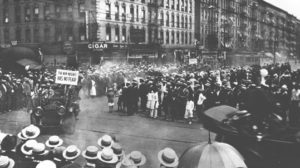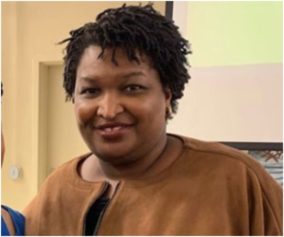
UNIA’s Harlem Parade (Photo via blackbusinessnetwork.com)
In the Post-Reconstruction era, the two most active outpourings of mass political organizing in the Black community took place in the 1920s and mid-century. Each period had numerous competing political lines inclusive of a sharp upswing in nationalist sentiment. Several factors played a role in the rise of activity and nationalism: overtly racist laws that could be battled; brutal white violence (Red-Summer/lynchings/Jim Crow); international upheaval; and the cry for self-determination and against imperialism after major European wars. There was also the advancement in international communism/socialism and revolutionary nationalism as alternative ideologies for liberation struggles that became widely known.
During these periods, two organizations in the U.S. dominated self-determination politics: the Universal Negro Improvement Association and the Nation of Islam. Both were able to pierce the consciousness of a critical mass of Black people and become important carriers of the ideological dreams of large segments of the community. They focused on building organizations that spoke truth to power and developing commercial enterprises that could impress and impact the larger Black community.
In relative obscurity, Marcus Garvey built the UNIA and positioned it on the world stage. Headquartered in New York, it became the largest organization in Black history, nationalist/Pan Africanist or otherwise, with over 2 million members worldwide (Wow! Imagine if UNIA had a Facebook page!).
Its ability to develop commerce and create institutions and customs that promoted cultural pride and self-defense gained it a legacy it still has today amongst the poor and working-class Black community. Garvey and the UNIA touched an ingrained human nerve, to not ask for or even demand to be integrated into a society that discriminates against you. Instead of taking on a default position of the powerless, the UNIA focused on the desire to build a society that can lay claim to protecting the interest of your people. The powerful concept of nationalism, even with all of the internal mistakes made by Garvey, created a resilient support base. It took the weight of the federal government and its first COINTELPRO operation to finally cause the downfall of Garvey and eventually the movement he led. However, the UNIA remained alive through Garvey’s imprisonment, deportation and death. While obviously the UNIA was left in a much weakened state after Garvey’s arrest, the idea was never completely destroyed. Every time you or I speak of self-determination or we “buy Black,” we are invoking Garvey.
The Nation of Islam, which derives parts of its ideology from the Garvey movement, also deserves study by those interested in moving Black independent politics forward.
The NOI capacity to build business enterprises, particularly in the 1950s and 1960s — teamed with the dynamic activism of Malcolm X and the alternative vision of building a Black society — made the Nation a creditable alternative to the dominant integrationist approach of the early 1960s. In general, the Black working-class and poor viewed the NOI as a potential protector and organizer of the community. The ability of the NOI to maintain community respect is astounding considering its trials and tribulations.
The NOI has been constantly ravaged in corporate media, by mainstream politicians and Black leaders throughout its existence. It’s a Muslim organization amongst an overwhelmingly Black Christian population; it has survived its own role in the killing of Malcolm X – its leading organizer who grew to legendary status in the Black community after his assassination; COINTELPRO operations and infiltration of its leadership; the death of its leader and leading figure Elijah Muhammad followed by the temporary breakup of the organization. None of this has been enough to destroy the organization as compared to other prominent groups of the 1960s. Less than 15 years ago, the NOI organized the largest gathering of Black people (overwhelmingly men) in the history of this country much past its own peak years.
The rhetorical abilities of Minister Farrakhan, the NOI’s still substantial business holdings, and its grassroots connections still make it relevant today, even if somewhat diminished. The NOI could become a leading force in the Black community by choosing to commit to a strategy of controlling a contiguous land mass (as its ideology states) as opposed to being spread out across the United States. But the potential confrontation with the state and the comfortable life of its top leadership, as in the past, suggest such a strategy won’t be employed.
These organizations present some obvious lessons for young activists to consider in planning future attempts to create dynamic radical change in our community. In developing next steps for organizing, lessons can be learned from what the organizations accomplished and what they didn’t. Here are some that individuals and organizations should consider in creating a Black movement.
Lesson 1 – Choosing Geographical Spaces For Our Organizing Efforts
Both groups focused on land but never created liberated territory. They never controlled the political apparatus of any land mass. Garvey made actual attempts in Africa, but was met with expected resistance from local and international players. In the states, the UNIA and the NOI followed a similar pattern of opening up “chapters” wherever they could, but with apparent little thought to where the most strategic places to build were, as opposed to the most popular areas to gain attention. The NOI in its mission statement called for the establishment of separate territory for Black people in the United States, but it did not proactively move its resources toward such a goal. There were passing ideas that seemed meant more for theatrics than the actual relocating of resources and bodies where the possibilities of Black control over political and economic structures could be attempted.
Today we need to choose strategic geographic locations if our goal is to push further than in the past. Without attempting this strategy, our movement will always succumb to stronger forces because our access to control resources and develop economic plans will be so limited as to not matter. Broadening our approach to think more expansively than neighborhood/community organizing but more locally than national efforts. The neighborhood/community model gives us little room to win control over important local seats in government. This leaves us in a situation that makes our groups easy to squeeze by larger forces.
Starting national campaigns requires a great deal of money and influence that our groups individually or collectively don’t have. This again makes us easily ignored or demagogued if necessary by national media. Specific action on a national level also bumps up against the majority support our community has for the Obama administration. So while the position might be right, it would likely result in even less community support. This is still not yet a revolutionary time in America. Efforts to discredit radical politics or militant calls are relatively easy, particularly if they come from Black organizers. Besides rhetorical cries, we won’t see any return on our effort because we won’t be able to project our message. People will counter, “Look at Occupy. Why can’t we do that?” Simply put, it is a white-led movement which was able to gain media access through mass arrest. Our groups have not shown the ability or desire to sustain such an effort or to agree to move forward on such ideas. In a non-political fashion, mass arrests are already taking place in our community and have not seemed to capture the attention of corporate media nor have they spurred our larger community to action.
Our movement needs to recognize the political reality of our position to ensure that we don’t engage in plans which satisfy the few but do nothing to shift the conditions and political reality of our community. Considering the limited resources of movement groups, we have to stake out a plan of action that is strategic and worthy of our efforts. By targeting a city/town of appropriate size and demographics, we can create a buffer from attack, place people in needed positions, gain access to resources and create a model of development. In addition, a small city can have enough fronts of struggle to create excitement, by emphasizing the need for community organizing where we can gain solid victories. The focus on a city takes into account our strengths and weaknesses and diminishes the ability to isolate radical/progressive politics if it has support.
Lesson 2 – Individual Choice vs. Larger Community Needs; Where Should I As An Individual Organize?
An analysis of where to organize should start with where our efforts can gain results. One should look at the number of fellow activists and organizations in close approximation. What is the access to resources and how they can be used to develop ideas on building commercial enterprises? What are the demographics of the community, city and state that one lives in? These should be some of the primary questions to ask.
Many of us come from or live in neighborhoods where we eventually want to live and organize. However, should we make a serious analysis of where to organize based on these personal sentiments? I know organizers who move for love, jobs and education all the time. Most will never consider moving for the movement they sometimes swear to.
There may be a sense of abandonment if we move, but it may be a self-defeating process to stay when the opportunity to make changes is limited. Does it make sense for us to stay where we represent a considerable minority like in large cities but are constantly out-maneuvered by larger forces? In large cities, those in power easily play upon racial differences. Corporate media manipulate issues of crime and poverty and boot-strap images to convince us our poverty is self-inflicted. Police brutality is always seen as a “bad apple” issue and never systemic. Again, without the resources to counter, we are left “spitting in the wind.” In large numbers, Black people are returning to the South for a less expensive lifestyle and to escape big-city police forces. Organizers must follow the people and evaluate location based on where it makes sense to organize — which may not be where we are comfortable, but it is where we are needed.
Lesson 3 – Choose an Organization Carefully but Choose One.
I understand and support individual efforts to create institutions that support our community. This is sometimes led by the desire to get away from personality conflicts (I apologize to all those I conflict with who have personalities). Those aspects of social interactions that happen whenever more than one person gathers can’t be avoided, although they should be addressed. This alone should not be reason enough to stay out of political organizations. Political organizations have to do a better job of understanding the psychology and making groups more attractive as to make our groups as personally fulfilling as religious or spiritual groups, trade organizations or other groups we join for personal gain. Knowing that people today have a shorter attention span and crave immediate satisfaction from their activities is both a challenge for groups and individuals as we pursue movement building.
The importance of an organizational apparatus is that when events lead to upheavals, organizations can turn those events into movements, rebellions and revolutions. Sometimes organized movements facilitate action, and sometimes they are in the backdrop of so-called spontaneous events (that are usually planned but make better propaganda if we are told it was organic) that cause a spark. Even in those cases where loosely organized groups or individuals help create motion, they are very rarely prepared for the outcomes. This does not mean that organizations will make the right moves but it does means they are ready to make different moves.
Looking at the uprisings in North Africa and the Arab world, the groups who were most organized did not necessarily start or trigger mass action. They were however able to take advantage and become the leading forces after the initial actions. While organizations can be destroyed and are constantly shifting and changing, their structure and collective resources allow for movements to reach new levels, and it’s important to be a part of them.
Lesson 4 – Commerce has to be part of an organization’s plan, otherwise there will be no growth and no sustainability
Organizations that desire to gain the attention of the Black masses must build an economic engine that can impress the larger community and provide services to the community. As a so-called minority group who sees the riches of American capitalism everyday and is fed a diet of Horatio Alger tales – commerce matters. The ability to showcase what economic progress looks like strikes a chord in the larger Black community. This is obviously difficult to achieve because Black people post-Jim Crow and the Black Power movement put less emphasis on where we buy and who we buy from. In many ways a closed unequal racial economic and political order allowed for Black community economic opportunities that a more open unequal economic system does not. We can count off the number of Black targeted enterprises which are not Black-owned. This is most damaging when it comes to the information industry. Discussion is either nonsensical because it’s about the celebrity and sports world, the new opiate of the masses. Or the range of debate is limited to integrationist minded liberal vs. conservative. Broader discussions are left out of corporate media because of the danger they pose in challenging American patriotism, race relations, foreign policy, etc. Corporate sponsored diversity, which means it’s OK to hire a few more Black faces as long as we get all the Black cash, will not allow discussions that go beyond the paradigm that is set.
Without a plan that is sustainable, the Black community will probably agree with the ideas espoused but will not join and support those groups. The “branding” of both the NOI and UNIA was established partly through its ability to show how working within the organizations could actually change one’s economic status for the better. People who could not and did not want to achieve status in the American political system found an alternative. The NOI in particular moved from small business ventures to owning millions of dollars worth of property and land. Yes, bean pies and Muhammad Speaks/Final Calls are what the Nation is known for, but at one point it owned restaurants, book and grocery stores and farm land. The UNIA did much the same but also ventured into eye-opening enterprises to capture the imagination of the Black world.
Any plan today has to start small and has to be practical in raising money outside of the funding word and dues collection. Again depending on location, pooling relatively small sums of money can lead to small economic enterprise, like taxi companies, rental property, grocery stores, gas stations, etc. These small business ideas can be the generators of wealth for an organization that does it correctly. On a larger scale, if there is a focus on taking the reins of a small city/town, we can demonstrate how public/private partnerships can work, land trust ideas, and public-led development. Without tackling these issues, the rhetoric of change will not impress a critical mass of our people.
Conclusion
There are of course great challenges to movement building. Overreaching is a continual mistake made by movement groups. We decide to duplicate the vision of larger organizations but miss the mark on planning. The ability to create achievable strategic plans is essential in creating the conditions that can build a movement. The need for creating a strong propaganda network that can highlight tangible work is a staple of any organization that wants community support. Although there are more tools open to us today, via social networking sites and other new media, we also have to contend with the over stimulation of information people receive today. Although most of it is corporate waste, it serves its purpose of keeping us intrigued with everything outside of our conditions and viable ways to address them.
Even after gaining success, many pitfalls are waiting. Commerce breeds conservatism, personalities lead to disagreements and growth brings new ideological mixes that have to mold together. Of course the biggest challenge will be the State and a compliant corporate media apparatus that will work to crush by force and or propagandize anything that seems successful and is outside the paradigm of what is allowed. However these are the problems that dedicated organizers should want to have because this means progress as opposed to living our lives in small-group encampments where event-planning becomes the staple for successful movement practices.
This generation has to learn from both the mistakes and successes of what is now a more distant past and push to make progress that can be measured not by how many talks we give but how many lives we change by creating a real Black movement.
Kamau has been a dedicated community organizer and movement attorney for over twenty years, first in New York City and now based in the south. For 18 years he was a leading member of a national grassroots organization dedicated to the ideas of self-determination and Malcolm X. He worked on various issues including youth organizing and development, police misconduct, and creating sustainable urban communities. Kamau has led and developed community cop-watch programs, freedom school programs for youth, large scale community gardens and alternatives to incarceration programs.


